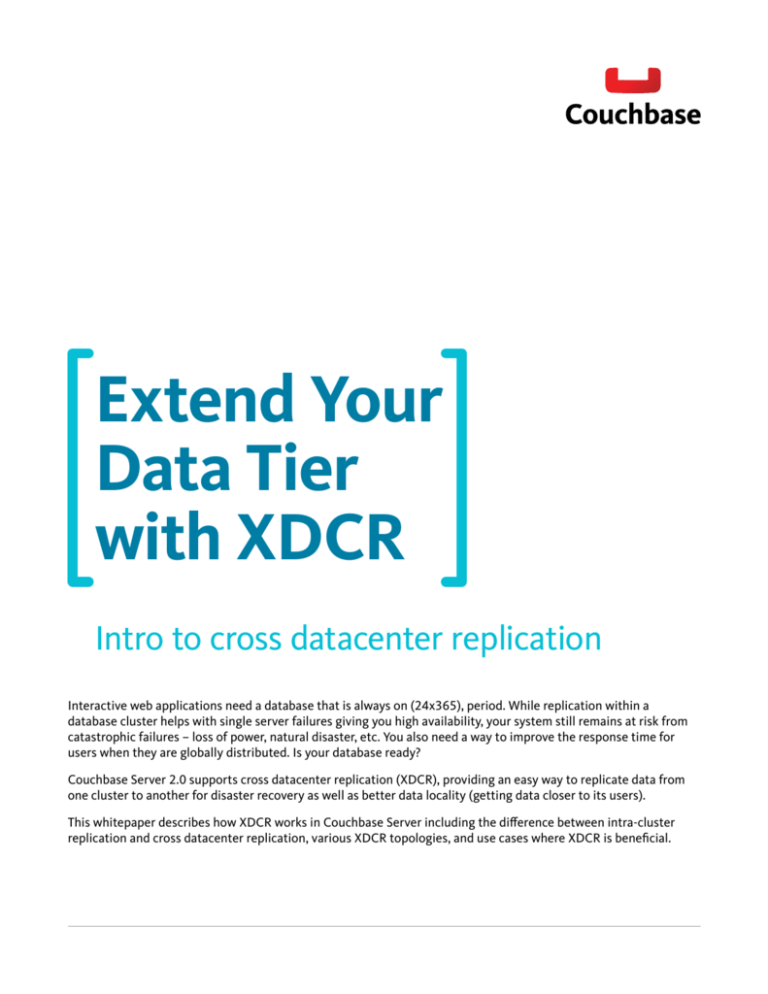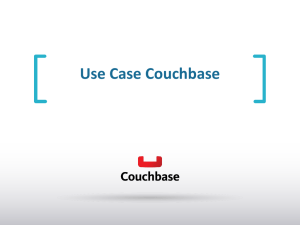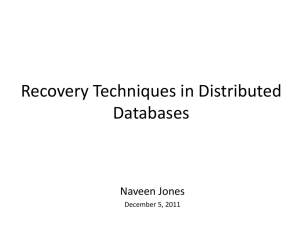
Extend Your
Data Tier
with XDCR
Intro to cross datacenter replication
Interactive web applications need a database that is always on (24x365), period. While replication within a
database cluster helps with single server failures giving you high availability, your system still remains at risk from
catastrophic failures – loss of power, natural disaster, etc. You also need a way to improve the response time for
users when they are globally distributed. Is your database ready?
Couchbase Server 2.0 supports cross datacenter replication (XDCR), providing an easy way to replicate data from
one cluster to another for disaster recovery as well as better data locality (getting data closer to its users).
This whitepaper describes how XDCR works in Couchbase Server including the difference between intra-cluster
replication and cross datacenter replication, various XDCR topologies, and use cases where XDCR is beneficial.
Intra-cluster replication vs. cross datacenter replication (XDCR)
Couchbase Server provides support for both intra-cluster replication and cross datacenter replication (XDCR).
Intra-cluster replication is the process of replicating data on multiple servers within a cluster in order to provide
data redundancy should one or more servers crash. Data in Couchbase Server is distributed uniformly across all the
servers in a cluster, with each server holding active and replica documents (see Figure 1). When a new document
is added to Couchbase Server, in addition to being persisted, it is also replicated to other servers within the cluster
(this is configurable up to three replicas). If a server goes down, failover promotes replica data to active data.
Figure 1: Replication within a cluster in Couchbase Server
Cross datacenter replication in Couchbase Server involves replicating active data to multiple, geographically
diverse datacenters either for disaster recovery or to bring data closer to its users for faster data access, as shown
in Figure 2.
Figure 2: Cross datacenter replication in Couchbase Server
You can also see in Figure 2 that XDCR and intra-cluster replication occurs simultaneously. Intra-cluster replication
is taking place within the clusters at both Datacenter 1 and Datacenter 2, while at the same time XDCR is
replicating documents across datacenters. Both datacenters are serving read and write requests from
the application.
Extend Your Data Tier with XDCR
1
Basic topologies
XDCR can be configured to support a variety of different topologies; the most common are unidirectional
and bidirectional.
Unidirectional Replication is one-way replication, where active data gets replicated from the source cluster to the
destination cluster. You may use unidirectional replication when you want to create an active offsite backup,
replicating data from one cluster to a backup cluster.
Bidirectional Replication allows two clusters to replicate data with each other. Setting up bidirectional replication
in Couchbase Server involves setting up two unidirectional replication links from one cluster to the other. This
is useful when you want to load balance your workload across two clusters where each cluster bidirectionally
replicates data to the other cluster.
In both topologies, data changes on the source cluster are replicated to the destination cluster only after they are
persisted to disk. You can also have more than two datacenters and replicate data between all of them.
XDCR can be setup on a per bucket basis. A bucket is a logical container for documents in Couchbase Server.
Depending on your application requirements, you might want to replicate only a subset of the data in Couchbase
Server between two clusters. With XDCR you can selectively pick which buckets to replicate between two clusters
in a unidirectional or bidirectional fashion.
As shown in Figure 3, there is no XDCR between Bucket A (Cluster 1) and Bucket A (Cluster 2). Unidirectional XDCR
is setup between Bucket B (Cluster 1) and Bucket B (Cluster 2). There is bidirectional XDCR between Bucket C (Cluster 1)
and Bucket C (Cluster 2).
Figure 3: Replicating selective buckets between two Couchbase Server clusters
As shown in Figure 4, after the document is stored in Couchbase Server and before XDCR replicates a document to
other datacenters, a couple of things happen within each Couchbase Server node.
1. Each server in a Couchbase cluster has a managed cache. When an application stores a document in
Couchbase Server it is written into the managed cache.
2. The document is added into the intra-cluster replication queue to be replicated to other servers within
the cluster.
3. The document is added into the disk write queue to be asynchronously persisted to disk. The document is
persisted to disk after the disk-write queue is flushed.
Extend Your Data Tier with XDCR
2
4. After the documents are persisted to disk, XDCR pushes the replica documents to other clusters. On the
destination cluster, replica documents received will be stored in cache. This means that replica data on the
destination cluster can undergo low latency read/write operations.
Figure 4: XDCR triggered after documents are persisted to disk
XDCR architecture in Couchbase Server
There are a number of key elements in Couchbase Server’s XDCR architecture including:
Continuous replication
XDCR in Couchbase Server provides continuous replication across geographically distributed datacenters. Data
mutations are replicated to the destination cluster after they are written to disk. There are multiple data streams
(32 by default) that are shuffled across all shards (called vBuckets in Couchbase Server) on the source cluster
to move data in parallel to the destination cluster. The vBucket list is shuffled so that replication is evenly load
balanced across all the servers in the cluster. The clusters scale horizontally, more the servers, more the replication
streams, faster the replication rate.
Extend Your Data Tier with XDCR
3
Cluster aware
XDCR is cluster topology aware. The source and destination clusters could have different number of servers. If a
server in the source or destination cluster goes down, XDCR is able to get the updated cluster topology information
and continue replicating data to available servers in the destination cluster.
Push-based connection resilient replication
XDCR in Couchbase Server is push-based replication. The source cluster regularly checkpoints the replication
queue per vBucket and keeps track of what data the destination cluster last received. If the replication process
is interrupted for example due to a server crash or intermittent network connection failures, it is not required to
restart replication from the beginning. Instead, once the replication link is restored, replication can continue from
the last checkpoint seen by the destination cluster.
Efficient
For the sake of efficiency, Couchbase Server is able to de-duplicate information that is waiting to be stored on disk.
For instance, if there are three changes to the same document in Couchbase Server, and these three changes are
waiting in queue to be persisted, only the last version of the document is stored on disk and later gets pushed into
the XDCR queue to be replicated.
Active-active conflict resolution
Within a cluster, Couchbase Server provides strong consistency at the document level. On the other hand, XDCR
also provides eventual consistency across clusters. Built-in conflict resolution will pick the same “winner” on both
the clusters if the same document was mutated on both the clusters. If a conflict occurs, the document with the
most updates will be considered the “winner.” If the same document is updated the same number of times on the
source and destination, additional metadata such as numerical sequence, CAS value, document flags and expiration
TTL value are used to pick the “winner.” XDCR applies the same rule across clusters to make sure document
consistency is maintained.
Extend Your Data Tier with XDCR
4
As shown in Figure 5 below, bidirectional replication is set up between Datacenter 1 and Datacenter 2 and
both the clusters start off with the same JSON document (Doc 1). In addition, two additional updates to Doc 1
happen on Datacenter 2. In the case of a conflict, Doc 1 on Datacenter 2 is chosen as the winner because it has
seen more updates.
Figure 5: Conflict detection strategy in Couchbase Server
Easy configuration and monitoring
XDCR can easily be configured and managed through the Couchbase admin console. With just a few button clicks
in the admin console UI, you can setup XDCR between your Couchbase clusters and get granular XDCR stats for
source and destination clusters. For more details, you might want to refer to the XDCR documentation in the
Couchbase Server 2.0 admin guide.
Advanced topologies
By combining unidirectional and bidirectional topologies, you have the flexibility to create several complex
topologies such as the chain and propagation topology as shown below:
Figure 6: Designing a replication chain using unidirectional replication
Extend Your Data Tier with XDCR
5
In Figure 6, two unidirectional replication links are set up to form a chain replication topology between
Datacenter 1 and Datacenter 2, and between Datacenter 2 and Datacenter 3. Chain replication topology is
useful for minimizing datacenter network bandwidth because the cluster at the head of the chain only replicates
to the next cluster along the chain rather than all the clusters.
In Figure 7, there is one bidirectional replication link between Datacenter 1 and Datacenter 2 and two
unidirectional replication links between Datacenter 2 and Datacenters 3 and 4. Propagation replication can
be useful in a scenario when you want to setup a replication scheme between two regional offices and several
other local offices. Data between the regional offices is replicated bidirectionally between Datacenter 1 and
Datacenter 2. Data changes in the local offices (Datacenters 3 and 4) are pushed to the regional office using
unidirectional replication.
Figure 7: Using bidirectional and unidirectional replication to selectively replicate data between datacenters
Extend Your Data Tier with XDCR
6
Use cases
Disaster recovery is a common reason for implementing XDCR, but it is certainly not the only one:
Disaster recovery
Disaster can strike your datacenter at any time – often with little or no warning. With active-active cross datacenter
replication in Couchbase Server, applications can read and write to any geo-location ensuring availability of data
24x365 even if an entire datacenter goes down.
Bringing data closer to users
Interactive web applications demand low latency response times to deliver an awesome application experience.
The best way to reduce latency is to bring relevant data closer to the user. For example, in online advertising, submillisecond latency is needed to make optimized decisions about real-time ad placements. XDCR can be used to
bring post-processed user profile data closer to the user for low latency data access.
Data replication for development and test needs
Developers and testers often need to simulate production-like environments for troubleshooting or to produce
a more reliable test. By using cross datacenter replication, you can create test clusters that host subset of your
production data so that you can test code changes without interrupting production processing or risking data loss.
Additional reading
Cross datacenter replication (XDCR) in Couchbase Server 2.0 Documentation
About Couchbase
We’re the company behind the Couchbase open source project, a vibrant community of developers and users
of Couchbase document-oriented database technology. Our flagship product, Couchbase Server, is a packaged
version of Couchbase technology that’s available in Community and Enterprise Editions. We’re known for our easy
scalability, consistent high performance, 24x365 availability, and a flexible data model. Companies like AOL, Cisco,
Concur, LinkedIn, Orbitz, Salesforce.com, Shuffle Master, Zynga and hundreds of others around the world use
Couchbase Server for their interactive web and mobile applications. www.couchbase.com
Extend Your Data Tier with XDCR
© 2013 Couchbase all rights reserved | www.couchbase.com
7








